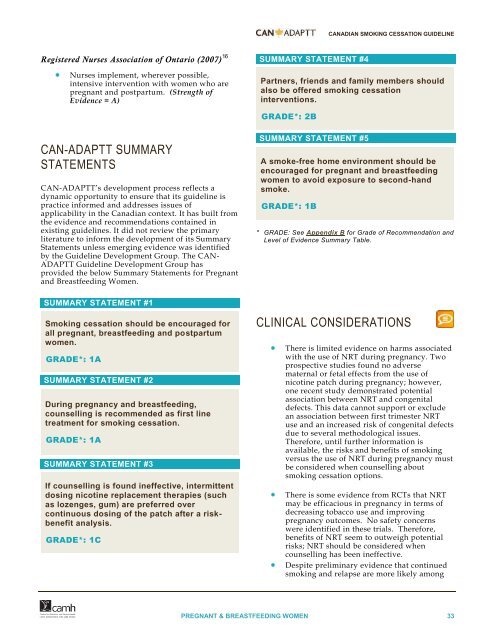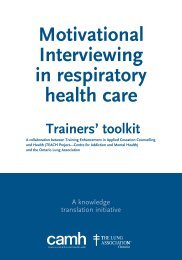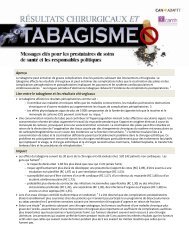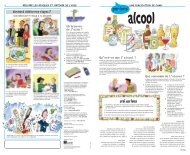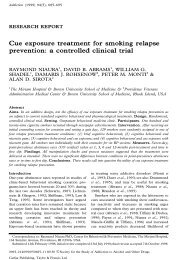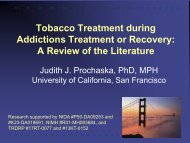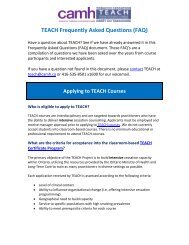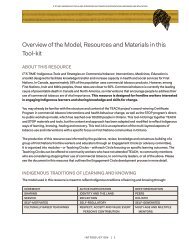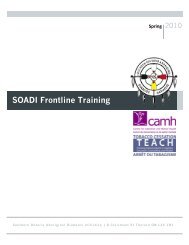Canadian Smoking Cessation Clinical Practice Guideline
Canadian Smoking Cessation Clinical Practice Guideline
Canadian Smoking Cessation Clinical Practice Guideline
You also want an ePaper? Increase the reach of your titles
YUMPU automatically turns print PDFs into web optimized ePapers that Google loves.
CANADIAN SMOKING CESSATION GUIDELINERegistered Nurses Association of Ontario (2007) 16Nurses implement, wherever possible,intensive intervention with women who arepregnant and postpartum. (Strength ofEvidence = A)SUMMARY STATEMENT #4Partners, friends and family members shouldalso be offered smoking cessationinterventions.GRADE*: 2BCAN-ADAPTT SUMMARYSTATEMENTSCAN-ADAPTT’s development process reflects adynamic opportunity to ensure that its guideline ispractice informed and addresses issues ofapplicability in the <strong>Canadian</strong> context. It has built fromthe evidence and recommendations contained inexisting guidelines. It did not review the primaryliterature to inform the development of its SummaryStatements unless emerging evidence was identifiedby the <strong>Guideline</strong> Development Group. The CAN-ADAPTT <strong>Guideline</strong> Development Group hasprovided the below Summary Statements for Pregnantand Breastfeeding Women.SUMMARY STATEMENT #1<strong>Smoking</strong> cessation should be encouraged forall pregnant, breastfeeding and postpartumwomen.GRADE*: 1ASUMMARY STATEMENT #2During pregnancy and breastfeeding,counselling is recommended as first linetreatment for smoking cessation.GRADE*: 1ASUMMARY STATEMENT #3If counselling is found ineffective, intermittentdosing nicotine replacement therapies (suchas lozenges, gum) are preferred overcontinuous dosing of the patch after a riskbenefitanalysis.GRADE*: 1CSUMMARY STATEMENT #5A smoke-free home environment should beencouraged for pregnant and breastfeedingwomen to avoid exposure to second-handsmoke.GRADE*: 1B* GRADE: See Appendix B for Grade of Recommendation andLevel of Evidence Summary Table.CLINICAL CONSIDERATIONSThere is limited evidence on harms associatedwith the use of NRT during pregnancy. Twoprospective studies found no adversematernal or fetal effects from the use ofnicotine patch during pregnancy; however,one recent study demonstrated potentialassociation between NRT and congenitaldefects. This data cannot support or excludean association between first trimester NRTuse and an increased risk of congenital defectsdue to several methodological issues.Therefore, until further information isavailable, the risks and benefits of smokingversus the use of NRT during pregnancy mustbe considered when counselling aboutsmoking cessation options.There is some evidence from RCTs that NRTmay be efficacious in pregnancy in terms ofdecreasing tobacco use and improvingpregnancy outcomes. No safety concernswere identified in these trials. Therefore,benefits of NRT seem to outweigh potentialrisks; NRT should be considered whencounselling has been ineffective.Despite preliminary evidence that continuedsmoking and relapse are more likely amongPREGNANT & BREASTFEEDING WOMEN 33


